Antibody data
- Antibody Data
- Antigen structure
- References [3]
- Comments [0]
- Validations
- Immunocytochemistry [9]
- Immunohistochemistry [4]
- Other assay [1]
Submit
Validation data
Reference
Comment
Report error
- Product number
- PA5-90724 - Provider product page

- Provider
- Invitrogen Antibodies
- Product name
- CD11b Polyclonal Antibody
- Antibody type
- Polyclonal
- Antigen
- Recombinant full-length protein
- Description
- Immunogen sequence: PQEDSDIAFL IDGSGSIIPH DFRRMKEFVS TVMEQLKKSK TLFSLMQYSE EFRIHFTFKE FQNNPNPRSL VKPITQLLGR THTATGIRKV VRELFNITNG ARKNAFKILV VITDGEKFGD PLGYEDVIPE ADREGVIRYV IGVGDAFRSE KSRQELNTIA SKPPRDHVFQ VNNFEALKTI QNQLREKIFA IEGTQT Positive Samples: THP-1, Mouse spleen, Mouse lung; Cellular Location: Membrane, Single-pass type I membrane protein
- Reactivity
- Human, Mouse, Rat
- Host
- Rabbit
- Isotype
- IgG
- Vial size
- 100 μL
- Concentration
- 2.94 mg/mL
- Storage
- -20°C, Avoid Freeze/Thaw Cycles
Submitted references Blending with transition metals improves bioresorbable zinc as better medical implants.
Targeting myeloid-derived suppressor cells to attenuate vasculogenic mimicry and synergistically enhance the anti-tumor effect of PD-1 inhibitor.
Neuroprotective effect of tormentic acid against memory impairment and neuro‑inflammation in an Alzheimer's disease mouse model.
Su Y, Fu J, Zhou J, Georgas E, Du S, Qin YX, Wang Y, Zheng Y, Zhu D
Bioactive materials 2023 Feb;20:243-258
Bioactive materials 2023 Feb;20:243-258
Targeting myeloid-derived suppressor cells to attenuate vasculogenic mimicry and synergistically enhance the anti-tumor effect of PD-1 inhibitor.
Li Y, Qiao K, Zhang X, Liu H, Zhang H, Li Z, Liu Y, Sun T
iScience 2021 Dec 17;24(12):103392
iScience 2021 Dec 17;24(12):103392
Neuroprotective effect of tormentic acid against memory impairment and neuro‑inflammation in an Alzheimer's disease mouse model.
Cui W, Sun C, Ma Y, Wang S, Wang X, Zhang Y
Molecular medicine reports 2020 Aug;22(2):739-750
Molecular medicine reports 2020 Aug;22(2):739-750
No comments: Submit comment
Supportive validation
- Submitted by
- Invitrogen Antibodies (provider)
- Main image
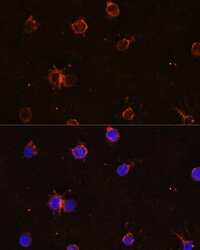
- Experimental details
- Immunocytochemistry-Immunofluorescence analysis of CD11b was performed in THP-1 cells using CD11b Polyclonal Antibody (Product # PA5-90724).
- Submitted by
- Invitrogen Antibodies (provider)
- Main image
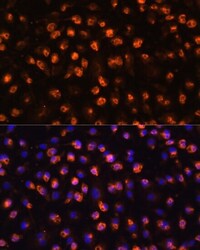
- Experimental details
- Immunocytochemistry-Immunofluorescence analysis of CD11b was performed in RAW264.7 cells using CD11b Polyclonal Antibody (Product # PA5-90724) at a dilution of 1:100. Blue: DAPI for nuclear staining.
- Submitted by
- Invitrogen Antibodies (provider)
- Main image
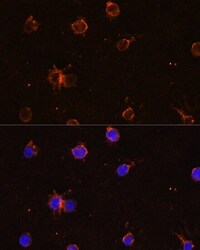
- Experimental details
- Immunocytochemistry-Immunofluorescence analysis of CD11b was performed in THP-1 cells using CD11b Polyclonal Antibody (Product # PA5-90724).
- Submitted by
- Invitrogen Antibodies (provider)
- Main image
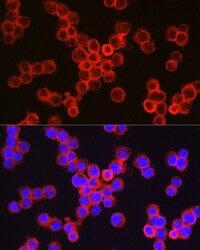
- Experimental details
- Immunofluorescence analysis of CD11b in TF-1 cells. Samples were incubated with CD11b Polyclonal antibody (Product # PA5-90724) using a dilution of 1:100 (40x lens). Blue: DAPI for nuclear staining.
- Submitted by
- Invitrogen Antibodies (provider)
- Main image
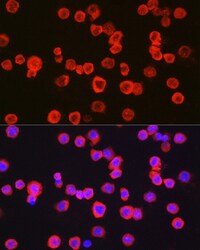
- Experimental details
- Immunofluorescence analysis of CD11b in THP-1 cells. Samples were incubated with CD11b Polyclonal antibody (Product # PA5-90724) using a dilution of 1:100 (40x lens). Blue: DAPI for nuclear staining.
- Submitted by
- Invitrogen Antibodies (provider)
- Main image
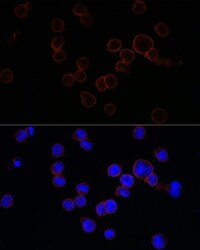
- Experimental details
- Immunofluorescence analysis of CD11b in TF-1 cells. Samples were incubated with CD11b Polyclonal antibody (Product # PA5-90724) using a dilution of 1:100 (40x lens). Blue: DAPI for nuclear staining.
- Submitted by
- Invitrogen Antibodies (provider)
- Main image
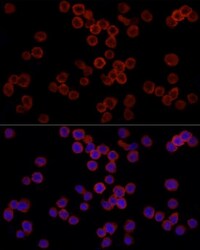
- Experimental details
- Immunofluorescence analysis of CD11b in THP-1 cells. Samples were incubated with CD11b Polyclonal antibody (Product # PA5-90724) using a dilution of 1:100 (40x lens). Blue: DAPI for nuclear staining.
- Submitted by
- Invitrogen Antibodies (provider)
- Main image
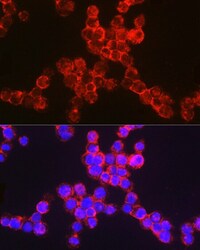
- Experimental details
- Immunofluorescence analysis of CD11b in TF-1 cells. Samples were incubated with CD11b Polyclonal antibody (Product # PA5-90724) using a dilution of 1:100 (40x lens). Blue: DAPI for nuclear staining.
- Submitted by
- Invitrogen Antibodies (provider)
- Main image
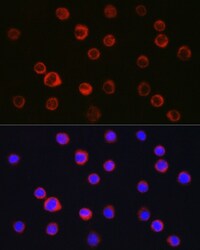
- Experimental details
- Immunofluorescence analysis of CD11b in THP-1 cells. Samples were incubated with CD11b Polyclonal antibody (Product # PA5-90724) using a dilution of 1:100 (40x lens). Blue: DAPI for nuclear staining.
Supportive validation
- Submitted by
- Invitrogen Antibodies (provider)
- Main image
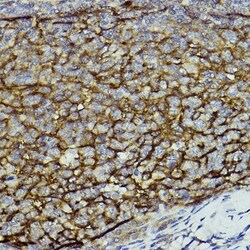
- Experimental details
- Immunohistochemistry analysis of CD11b in paraffin-embedded human tonsil. Samples were incubated with CD11b Polyclonal antibody (Product # PA5-90724) using a dilution of 1:100 (40x lens). Perform high pressure antigen retrieval with 10 mM citrate buffer pH 6.0 before commencing with IHC staining protocol.
- Submitted by
- Invitrogen Antibodies (provider)
- Main image
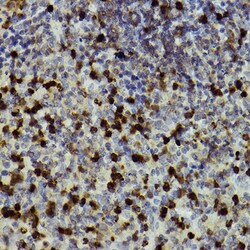
- Experimental details
- Immunohistochemistry analysis of CD11b in paraffin-embedded mouse spleen. Samples were incubated with CD11b Polyclonal antibody (Product # PA5-90724) using a dilution of 1:100 (40x lens). Perform high pressure antigen retrieval with 10 mM citrate buffer pH 6.0 before commencing with IHC staining protocol.
- Submitted by
- Invitrogen Antibodies (provider)
- Main image
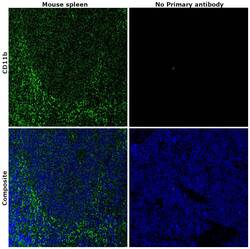
- Experimental details
- Immunohistochemical analysis of CD11b was performed using formalin-fixed paraffin-embedded mouse spleen tissue sections. To expose the target protein, heat-induced epitope retrieval was performed on de-paraffinized sections using eBioscience™ IHC Antigen Retrieval Solution - High pH (10X) (Product # 00-4956-58) diluted to 1X solution in water in a decloaking chamber at 110 degree Celsius for 15 minutes. Following antigen retrieval, the sections were blocked with 2% normal goat serum in 1X PBS for 45 minutes at room temperature and then probed with or without CD11b Polyclonal Antibody (Product # PA5-90724) at 1:100 dilution in 0.1% normal goat serum overnight at 4 degree Celsius in a humidified chamber. Detection was performed using Goat anti-Rabbit IgG (H+L) Highly Cross-Adsorbed Secondary Antibody, Alexa Fluor Plus 488 (Product # A32731) at a dilution of 1:2000 in 0.1% normal goat serum for 45 minutes at room temperature. Nuclei were stained with DAPI (Product # D1306) and the sections were mounted using ProLong™ Glass Antifade Mountant (Product # P36984). The images were captured on EVOS™ M7000 Imaging System (Product # AMF7000) at 20X magnification.
- Submitted by
- Invitrogen Antibodies (provider)
- Main image
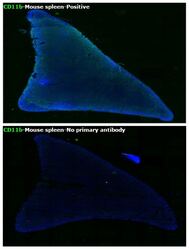
- Experimental details
- Immunohistochemical analysis of CD11b was performed using formalin-fixed paraffin-embedded mouse spleen tissue sections. To expose the target protein, heat-induced epitope retrieval was performed on de-paraffinized sections using eBioscience™ IHC Antigen Retrieval Solution - High pH (10X) (Product # 00-4956-58) diluted to 1X solution in water in a decloaking chamber at 110 degree Celsius for 15 minutes. Following antigen retrieval, the sections were blocked with 2% normal goat serum in 1X PBS for 45 minutes at room temperature and then probed with or without CD11b Polyclonal Antibody (Product # PA5-90724) at 1:100 dilution in 0.1% normal goat serum overnight at 4 degree Celsius in a humidified chamber. Detection was performed using Goat anti-Rabbit IgG (H+L) Highly Cross-Adsorbed Secondary Antibody, Alexa Fluor Plus 488 (Product # A32731) at a dilution of 1:2000 in 0.1% normal goat serum for 45 minutes at room temperature. Nuclei were stained with DAPI (Product # D1306) and the sections were mounted using ProLong™ Glass Antifade Mountant (Product # P36984). The images were captured on EVOS™ M7000 Imaging System (Product # AMF7000) at 20X magnification.
Supportive validation
- Submitted by
- Invitrogen Antibodies (provider)
- Main image

- Experimental details
- Figure 3. TA treatment decreases the area of CD11b-positive cells in amyloid beta precursor protein/presenilin 1 transgenic mice. Cells were visualized by immunohistochemical staining and the area of CD11b-positive cells was compared with the vehicle treatment group. (A) CD11b-positive cells in the PFC, indicated by white arrow. (B) CD11b-positive cells in the HC. Scale bar, 40 um. (C) Area of CD11b-positive cells in the PFC. (D) Area of CD11b-positive cells in the HC. Data are expressed as the mean +- SEM for the immunopositive area as % of the total surface area. n=5 in each group. **P
 Explore
Explore Validate
Validate Learn
Learn Western blot
Western blot ELISA
ELISA Immunocytochemistry
Immunocytochemistry